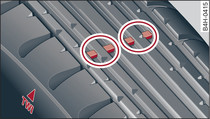
- Fig. 1 Tyre tread: Tread wear indicators
Tyre wear
Inspect the tyres regularly for damage.
- The wear on under or over-inflated tyres is significantly higher.
- Fast cornering, heavy acceleration and hard braking all increase tyre wear.
- If you notice excessive tyre wear, have the wheel alignment checked by a qualified workshop.
- Have your tyres rebalanced if steering wheel vibrations indicate an imbalance. Otherwise, the tyres and other parts of the vehicle may wear faster.
Tread wear indicators
The original tyres on your vehicle have 1.6 mm high tread wear indicators Fig. 1 running across the tread at regular intervals. The letters "TWI" or triangles on the sidewall indicate the positions of the tread wear indicators.
The minimum tread depth1) is reached at the latest when the tread is worn down to the tread wear indicators. Replace the tyres with new ones WARNING!.
Changing wheels round
Wheels should be changed round regularly to ensure that the wear is equal on all tyres. Fit the wheels from the rear axle on the front axle and vice-versa. All the tyres will then last for about the same time.
On tyres with a directional tread pattern, note the direction of rotation indicated on the sidewall ►Link.
Concealed damage
Damage to tyres and rims is often not readily visible. If you notice unusual vibrations or the car pulling to one side, this may indicate that one of the tyres is damaged. Reduce your speed immediately. Inspect the tyres for damage. If no external damage is visible, drive slowly and carefully to the nearest qualified workshop and have the car inspected.
Insufficient tread depth or different tread depths on different wheels reduce safety. This is particularly evident in vehicle handling, when there is a risk of aquaplaning in deep puddles of water and when driving through corners. Braking is also adversely affected – risk of accident!
1) Please observe the applicable regulations in the country in which you are travelling.